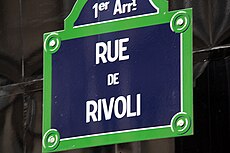Rue de Rivoli

Street plate
|
|
| Length | 3,070 m (10,070 ft) |
|---|---|
| Width | 20.78 m (68.2 ft) along the Jardin des Tuileries; 22 m elsewhere |
| Arrondissement | 1st, 4th |
| Quarter | Saint-Germain l'Auxerrois. Halles. Palais Royal. place Vendôme. Saint-Merri. Saint-Gervais. |
| From | 45 rue François Miron and 1 rue de Sévigné |
| To | place de la Concorde and 2 rue Saint-Florentin |
| Construction | |
| Completion | May 3, 1848 |
| Denomination | April 25, 1804 |
Coordinates: 48°51′24.90″N 2°21′13.22″E / 48.8569167°N 2.3536722°E
Rue de Rivoli (French pronunciation: [ʁy də ʁivɔli]) is one of the most famous streets of Paris, a commercial street whose shops include the most fashionable names in the world. It bears the name of Napoleon's early victory against the Austrian army, at the battle of Rivoli, fought January 14 and 15, 1797. The rue de Rivoli marked a transitional compromise between an urbanism of prestige monuments and aristocratic squares, and the forms of modern town planning by official regulation.
The new street that Napoleon Bonaparte pierced through the heart of Paris took for one side the north wing of the Louvre Palace, which Napoleon extended, and the Tuileries Gardens. For the first time ever, a handsome, regular, wide street would face the north wing of the old palace. Napoleon's original section of the street opened up eastward from the Place de la Concorde. Builders on the north side of the Place Louis XV, as it then was named, between rue de Mondovi and rue Saint-Florentin, had been constrained by letters patent in 1757 and 1758 to follow a single façade plan. The result was a pleasing uniformity, and Napoleon's planners extended a similar program, which has resulted in the famous arcaded facades that extend for almost a mile.
The restored Bourbon King Charles X continued the rue de Rivoli eastwards from the Louvre, as did King Louis-Philippe. Finally, Emperor Napoleon III extended it on into the 17th-century quarter of the Marais (see: Right Bank). Beneath the rue de Rivoli runs one of the main brick-vaulted oval-sectioned sewers of Paris' much-imitated system, with its sidewalks for the sewerworkers.
...
Wikipedia

